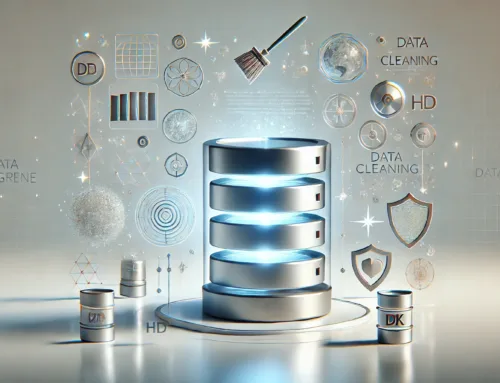You may be familiar with data hygiene services, but have you ever wondered about the top techniques utilized in ensuring clean, accurate data? From data parsing to data governance, each method plays a crucial role in enhancing the quality of your data. These techniques are not only essential for maintaining data integrity but are also fundamental for making informed decisions and optimizing your business operations. The intricacies of these top 10 techniques are worth exploring to understand how they contribute to the reliability and efficiency of your data management processes.
Data Parsing
When it comes to data hygiene services, one of the fundamental techniques employed is data parsing. Data parsing involves breaking down raw data into smaller components to facilitate data extraction, cleansing, segmentation, and aggregation.
Data extraction is the process of retrieving specific data elements from a dataset, and data parsing plays a crucial role in identifying and isolating these elements accurately. By parsing the data, unnecessary information is filtered out, leaving behind only the relevant data for extraction.
Furthermore, data cleansing, which involves correcting and removing errors and inconsistencies from the data, is made more efficient through data parsing. By parsing the data into distinct fields or categories, it becomes easier to identify and rectify any discrepancies or inaccuracies present.
In addition, data parsing enables effective data segmentation and aggregation. Segmentation involves categorizing data into groups based on specific criteria, while aggregation involves combining data from multiple sources into a unified dataset. Data parsing ensures that the segmentation and aggregation processes are carried out accurately, leading to more reliable and meaningful insights.
Data Transformation
Data parsing lays the foundation for the subsequent phase of data transformation in the realm of data hygiene services. During the data transformation process, data mapping and data aggregation play crucial roles. Data mapping involves restructuring data from its original format into a new format that aligns with the desired output, facilitating the integration of different data sources. Additionally, data aggregation involves combining multiple data points into a single, summarized view, aiding in the analysis of large datasets.
Furthermore, data transformation encompasses data cleansing and data normalization. Data cleansing involves identifying and correcting errors or inconsistencies within the dataset, ensuring accuracy and reliability. On the other hand, data normalization standardizes data to a common format, reducing redundancy and improving data consistency. By implementing these techniques, data hygiene services can enhance the quality and usability of the data, ultimately leading to more informed decision-making and improved business outcomes.
Data Matching
When it comes to data matching, there are several key techniques to consider. Fuzzy matching allows for finding similarities between data points that are not identical but share common elements. Exact matching, on the other hand, focuses on identifying precise matches between data sets. Record linkage involves connecting related data entries across different sources to create a unified view.
Fuzzy Matching
Fuzzy matching, a technique commonly employed in data hygiene services, is a method used to compare two strings of text and determine how similar they are to each other. Fuzzy matching algorithms play a crucial role in this process by allowing for variations in the data to be taken into account. These algorithms are designed to handle situations where there may be typos, misspellings, abbreviations, or other deviations in the text that need to be considered when comparing information.
Fuzzy matching applications are vast and can be seen in various data hygiene services such as deduplication, record linkage, and data standardization. By using fuzzy matching techniques, businesses can ensure that their databases are clean, accurate, and up to date. This method helps in identifying duplicate records, merging similar entries, and enhancing overall data quality. Incorporating fuzzy matching in data hygiene services leads to improved decision-making processes, better customer relationships, and more efficient operations.
Exact Matching
One critical aspect of data hygiene services is the practice of exact matching, also known as data matching. This technique plays a crucial role in ensuring data quality and accuracy. Exact matching involves comparing data sets to identify identical records through automatic identification. By utilizing exact matching in data cleansing processes, organizations can eliminate duplicates and inconsistencies within their databases, leading to improved overall data quality.
Exact matching works by comparing specific fields or attributes within datasets to determine if they match exactly. This process helps maintain data integrity and ensures that accurate information is used for decision-making purposes. Through the precise identification of matching records, organizations can streamline their data management processes and prevent errors that may arise from duplicate entries.
Implementing exact matching as part of data hygiene services is essential for maintaining a high standard of data quality. By leveraging this technique, businesses can enhance the reliability and effectiveness of their data for various applications and operations.
Record Linkage
How can organizations further enhance their data hygiene practices to ensure comprehensive data quality and accuracy? One key technique is record linkage, also known as data matching. Record linkage plays a crucial role in improving data hygiene by accurately and efficiently identifying and merging similar records from different data sources.
Linkage accuracy is essential in ensuring that the matching process correctly identifies and links records that refer to the same entity. By employing advanced algorithms and comparison methods, organizations can enhance linkage accuracy and reduce the risk of errors in the matching process.
Moreover, linkage efficiency is vital for optimizing the data matching process and achieving timely results. Efficient record linkage techniques help organizations streamline their data hygiene practices, saving time and resources while maintaining high accuracy levels.
Data Harmonization
When it comes to data harmonization, the focus lies on standardizing data formats to ensure consistency across different datasets. This process involves resolving any inconsistencies or discrepancies in the data, allowing for accurate analysis and reporting. By harmonizing data, organizations can streamline operations and make informed decisions based on reliable and uniform information.
Standardizing Data Formats
To ensure efficient data management and analysis, a crucial aspect of data hygiene services is the standardization of data formats, also known as Data Harmonization. Data cleansing involves removing inconsistencies and errors from datasets, while format normalization focuses on ensuring that data is presented in a consistent and uniform manner. By standardizing data formats, organizations can streamline their data processing workflows, improve data quality, and enhance the accuracy of analytical outcomes.
Format normalization in data hygiene services involves aligning data fields such as dates, addresses, and names to a consistent format across all records. This process helps eliminate redundancies, reduce errors, and enhance the overall integrity of the dataset. Standardizing data formats also facilitates data integration from multiple sources, enabling seamless data analysis and reporting. By implementing standardized formats, businesses can optimize their data management practices, enhance decision-making processes, and unlock valuable insights hidden within their datasets.
Resolving Data Inconsistencies
Resolving data inconsistencies through data harmonization is a critical process in data hygiene services. Data accuracy and integrity are paramount in ensuring that the information within a database is reliable and consistent. Data harmonization involves aligning different data sets to create a unified and standardized format, resolving any discrepancies or conflicts that may exist between them.
By harmonizing data, you can eliminate duplicates, correct inaccuracies, and ensure that all information is up to date and consistent across all records. This process not only improves the overall quality of the data but also enhances its usability and effectiveness for various analytical purposes.
Through data harmonization, you can achieve a single, comprehensive view of your data, which is essential for making informed decisions and drawing accurate insights. By maintaining data accuracy and integrity, you can increase the efficiency of your operations, enhance customer satisfaction, and drive better business outcomes.
Data Standardization
Data standardization is a crucial aspect of data hygiene services, ensuring that all information is consistently formatted and structured according to predefined rules and guidelines. Address normalization and data cleansing are key components of data standardization. Address normalization involves formatting addresses in a uniform manner, correcting spelling errors, abbreviations, and ensuring consistency across all records. This process is essential for enhancing data accuracy and improving mail deliverability rates.
Data cleansing, on the other hand, focuses on identifying and correcting errors in data, such as duplicates, inaccuracies, and inconsistencies. By standardizing data through cleansing processes, organizations can eliminate redundancies, improve data quality, and enhance decision-making capabilities. Standardized data enables better analytics, reporting, and overall operational efficiency. It also facilitates effective communication with customers and stakeholders, as standardized data ensures that messages are clear and consistent.
Data Deduplication
When it comes to data deduplication in the realm of data hygiene services, your primary goal is to eliminate duplicate data entries. By streamlining data records and removing redundancies, you are paving the way for more efficient data management processes. Ultimately, this process enhances data accuracy and ensures that you are working with the most reliable information available.
Eliminating Duplicate Data
Identifying and removing duplicate data is a crucial step in ensuring data accuracy and reliability. When it comes to eliminating duplicate data, data hygiene services employ advanced techniques to streamline information management. Here are four key methods used for data deduplication:
- Duplicate Detection Algorithms: Specialized algorithms are utilized to scan data sets and identify redundant entries accurately.
- Fuzzy Matching: This technique helps in identifying duplicates even when entries have slight variations or errors by comparing strings for similarities.
- Unique Identification: Assigning unique identifiers to each data record aids in distinguishing between duplicates and original entries more effectively.
- Automated Deduplication Tools: Leveraging automated tools streamlines the process of identifying and eliminating duplicate data, saving time and ensuring thoroughness in the deduplication process.
Streamlining Data Records
To effectively streamline data records through data deduplication, focus on implementing efficient techniques that enhance data accuracy and overall quality. Data cleansing plays a crucial role in this process by identifying and removing duplicate entries, ensuring that only accurate and relevant information is retained. By organizing data systematically, you can streamline records for easy access and analysis.
Data refinement is another key aspect of data deduplication. This involves standardizing formats, correcting errors, and updating outdated information. Through data consolidation, merge duplicate records into a single, accurate entry, eliminating redundancy and improving data consistency.
Enhancing Data Accuracy
To enhance data accuracy through data deduplication, you must focus on scrubbing your database meticulously. Data cleansing and error detection are crucial steps in this process. Follow these steps to ensure accuracy improvement and implement verification techniques:
- Identify Duplicates: Utilize advanced algorithms to detect duplicate entries within your database accurately.
- Merge Duplicate Records: Develop a systematic approach to merge duplicate records while preserving essential information.
- Regular Data Audits: Conduct routine data audits to maintain a clean database and identify potential duplicates promptly.
- Implement Data Validation Rules: Set up stringent data validation rules to prevent the entry of duplicate records in the future.
Data Verification
When it comes to ensuring the accuracy and reliability of your data, data verification plays a crucial role in the process. Data cleansing involves the identification and correction of inaccuracies or inconsistencies within a dataset, while address validation specifically focuses on verifying the correctness and completeness of addresses.
Data verification ensures that the information within your database is up-to-date and accurate. By utilizing address validation techniques, such as standardizing addresses, checking for missing elements, and validating postal codes, you can enhance the quality of your data. This process not only improves the overall integrity of your database but also helps in avoiding errors that may arise from incorrect or incomplete address information.
Address validation, a key component of data verification, is essential for businesses that rely on accurate customer information for marketing campaigns, shipping logistics, and customer communication. By incorporating robust data verification practices, you can maintain a high level of data quality, leading to increased operational efficiency and customer satisfaction.
Data Validation
How can you ensure the accuracy and integrity of your data? Data validation is crucial in maintaining high-quality data. By implementing effective data validation techniques, you can enhance the reliability of your information. Here are some key steps to consider:
- Field Validation: Validate specific data fields to ensure they meet predefined criteria, such as format, range, or type.
- Cross-Field Validation: Check the relationship between different fields to detect inconsistencies or errors that might not be apparent when looking at individual fields in isolation.
- Data Integrity Checks: Conduct checks to maintain the overall consistency and accuracy of the data by identifying any anomalies or discrepancies.
- Real-Time Validation: Implement validation processes in real-time to immediately flag and correct errors as data is entered or updated, preventing inaccuracies from propagating.
The importance of data validation cannot be overstated. By employing these techniques, you can uphold the quality and reliability of your data, leading to better decision-making and improved operational efficiency.
Data Enrichment
Enhancing the depth and value of your data is a critical aspect of data management, and one way to achieve this is through Data Enrichment. Data enrichment involves augmenting existing data with additional information to improve its quality and completeness. By enriching your data, you enhance its accuracy and usefulness for analysis and decision-making processes.
Data augmentation is a key component of data enrichment, where missing or incomplete data points are filled in using external sources or algorithms. This process helps ensure that your dataset is comprehensive and reliable. Moreover, data enrichment goes beyond just filling in missing information; it also involves enhancing existing data with additional attributes or details to provide more context and insights.
Data Profiling
Data Profiling involves examining and analyzing your dataset to gain a comprehensive understanding of its structure, quality, and content. This technique is crucial in ensuring data quality and adhering to data governance principles. Here are four key aspects of data profiling:
- Identifying Data Quality Issues: By conducting data profiling, you can uncover inconsistencies, inaccuracies, and missing values within your dataset. This process allows you to address these quality issues promptly.
- Detecting Data Anomalies: Data profiling helps in detecting anomalies such as duplicate records, outliers, and inconsistencies in data formats. Identifying these anomalies is essential for maintaining data integrity.
- Establishing Data Relationships: Through data profiling, you can establish relationships between different data elements. This step is vital for understanding how data entities are interconnected within the dataset.
- Improving Data Governance: Data profiling plays a significant role in enhancing data governance practices by providing insights into data usage, lineage, and overall data health. This information is crucial for making informed decisions regarding data management strategies.
Frequently Asked Questions
How Can Data Hygiene Services Improve Data Privacy Compliance?
To enhance data privacy compliance, data hygiene services implement thorough data protection measures. By employing techniques like deduplication and data validation, they ensure compliance with regulations, mitigating risks associated with inaccurate or obsolete data.
What Are the Benefits of Real-Time Data Enrichment?
When it comes to real-time data enrichment, picture a finely tuned orchestra hitting every note perfectly. This precision leads to improved targeting and enhanced personalization, ensuring your data is always up-to-date and delivering meaningful insights instantly.
Can Data Hygiene Services Help in Identifying Data Anomalies?
Yes, data hygiene services are crucial for identifying data anomalies. By utilizing advanced data cleansing techniques, anomalies like duplicate records and inconsistencies can be detected and resolved, ensuring your data is accurate and reliable for informed decision-making.
How Does Data Harmonization Enhance Data Analytics?
Data harmonization enhances data analytics by ensuring consistent formats across sources, leading to enhanced accuracy and improved insights. By aligning data elements, you streamline analysis processes and uncover deeper correlations, boosting the value of your data.
What Role Does Data Validation Play in Data Quality Maintenance?
In data quality maintenance, data validation is crucial as it ensures data accuracy and integrity. By verifying data against predefined rules and standards, errors are identified, leading to cleaner datasets and more reliable decision-making processes.




